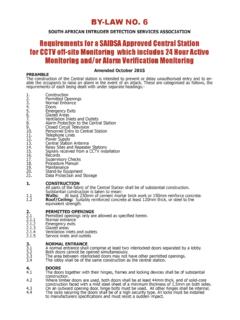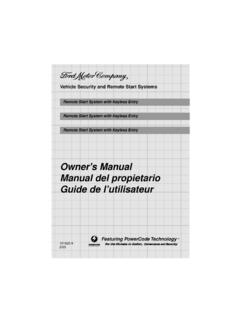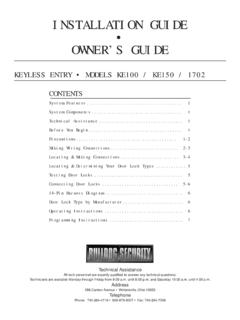Transcription of BY-LAW NO. 5 - Saidsa.co.za
1 South African Intruder Detection Services Association BY-LAW NO. 5 Standard installation Specification for Intruder Alarm Systems for Domestic, Commercial, Retail and Industrial Installations Amended September 2015 1. GENERAL This specification lays down the minimum requirements for the construction, installation , operation and maintenance of intruder alarm systems in buildings. Specifications herein contain requirements to be applied in the aforesaid. Any deviation is to be indicated on the installation certificate and such deviation should not be seen as an acceptance of compliance. SAIDSA does not accept any liability and/or responsibility for any defect there may be now or hereafter in the installation or any loss suffered by any party, due to its failure to operate at any time and no warranty or condition expressed or implied whether statutory or otherwise is given by SAIDSA in regard to the above installation either to the approved installer or to the customer.
2 This specification does not purport to cover all the necessary requirements for a particular installation and all efforts should be made to ensure correct risk assessment. The client must be clearly informed that the installed equipment does not prevent intrusion but is intended to detect or deter intrusion. This entire BY-LAW must be read in conjunction with the appropriate annexures. All equipment must be installed to manufacturer s specifications. 2. DEFINITIONS For the purposes of this specification the following definitions apply: 24-Hour Zone: A zone that is permanently armed (Panic button, tamper switch). Alarm condition: A condition whereby the alarm system, when armed, activates indicating a violation of any detection device.
3 Alarm company: A SAIDSA-ap proved installation organisation prepared to enter into a contract for the provision of the installation and/or monitoring, reaction and maintenance of an intruder alarm system. APP (smartphone application): A mobile app (application software) is a computer program designed to run on smartphones, tablet computers and other mobile devices. Apps can be used for the view or control of remote systems, including alarm or video security equipment. The APP should be sufficiently secure to prevent its misuse by third party. It is recommended that upon arming/disarming and bypass, the user ID is recorded in the control panel event log or server. Arming: Putting an intruder alarm system or part of it (switching on of the alarm) into such a condition that an alarm condition created by any of the associated detection devices in the alarmed area is signalled.
4 Back up battery: Device responsible for ensuring a constant supply of backup power to the intruder alarm system in the event of a power failure. Balanced circuit: A closed circuit so arranged that severance or shorting-out of any protective switch, detection device or wiring of the intruder alarm system will cause a detectable change in the resistance of the circuit. Central station/control room: Continually manned premises, equipped to receive and display signals from intruder alarm systems which complies with the requirements of BY-LAW 1 of SAIDSA and is prepared to enter into a contract for the provision of alarm monitoring. Cloaking: The deliberate covering of an intruder using infrared blocking materials with the intent of hiding the infrared emission of the human body.
5 Anti-cloaking: A specific detector used to detect the deliberate covering of an intruder with infrared blocking materials. Closed circuit: A circuit within an intruder alarm system which when opened creates an alarm condition. Closed circuit device: A device arranged to create an alarm condition by opening a closed circuit. Code hopping: A rolling code (Also called a hopping code) used in keyless entry systems to prevent the capture and recording of the code for duplication purposes. Such systems are typical in alarms, garage door openers and keyless car entry systems. Control equipment: Equipment including switches, relays, indicators and other apparatus necessary for arming, disarming and/or programming intruder alarm system for activating signalling equipment and for indication of faults.
6 Delay Zone: A Detection Circuit which when the control equipment is armed will provide a time delay for the purposes of entry and exit arming or disarming. Deliberately operated device ( (panic button, glass break call point): A device permitting the subscriber or his staff to deliberately create an alarm condition. 1 Detection circuit: Circuit by means of which one or more detection devices or deliberately operated devices are connected to the control or signalling equipment of an intruder alarm system. Detection device electronic ( passive infrared, microwave, glass break detector) : Apparatus or section of wiring intended to detect the entry or attempted entry of an intruder. Digital communicator: Equipment for the transmission of electronic signals through the telephone system to the central station/control room to a receiving device, which acknowledges receipt of the signal.)
7 Disarming: Putting an intruder alarm system or part of it into such a condition that an alarm condition created by any of the alarm conditions in the disarmed area, will not be registered in the central station (switching off of alarm). Double pole circuit: A closed circuit so arranged that throughout its length there are two or more adjacent conductors in different electrical states and such that an alarm and/or fault condition is generated if the two conductors are connected together or if either closed circuit is opened. End of line resistance: A closed circuit so arranged that at severance or shorting-out of any part of the wiring will cause a detectable change in the resistance of the circuit.
8 External sounder: Signalling equipment consisting of a sound-producing device. Follower zone: A Detection Circuit which when the control equipment is armed and subsequently violated, prior to a Delay Zone being violated, results in an instant alarm. Should a delay zone be triggered first, this zone will be treated as a delay zone. Instant Zone: A Detection Circuit which when the control equipment is armed and subsequently violated, results in an instant alarm. Internal sounder: Signalling equipment consisting of a sound-producing device so situated within the protected premises. Intruder alarm system: A means of detecting and signalling the presence, entry or attempted entry of an intruder into a protected premises.
9 For the purposes of this BY-LAW , it is specifically noted that the use of wireless/wirefree systems is permitted. Isolate (bypass): A deliberate action whereby part (circuit) of the alarm system is disabled during a single alarm state and does not have the ability to signal an alarm condition. Jamming: The transmission of radio signals with the purpose of interfering with the correct operation of wireless networks to disrupt information flow, including alarm, GSM, Radio and CCTV equipment in a security installation . Masking: The deliberate or accidental covering or blocking of a detector where the detector is unable to detect infrared. Anti-masking: A detector specifically designed to detect the covering or blocking of a detector.
10 Multiplex circuit: A multiple detection device circuit arranged in such a way that operation of a single detection device will signal the identity of that device to the control equipment. The multiplex cabling must be tamper protected. Multi-Shot: A circuit capable of multiple Alarm Conditions during a single arming period. Open circuit: A circuit within an intruder alarm system which when closed creates an alarm condition. Open Circuit device: A device arranged to create an alarm condition by closing an open circuit. Power supply equipment: Equipment providing power for the retaining of the battery in a good state of charge and for the operation of any component part of an intruder detection system, either independently or through the control equipment.













